Helena P. Schrader's Blog, page 41
May 20, 2017
Life and Lifestyle in the Crusader States: Clothes and Fashion
The perishable nature of clothing inhibits our ability to know exactly or in great detail how the residents of Outremer dressed. We have to rely on the textile and garment fragments that have been found, contemporary artistic depictions and literary descriptions. Of these sources, depictions and descriptions both suggest that the fashion in crusader states was set in Paris more than Damascus, but this does not mean that modifications were not made to accommodate the weather and other conditions in the Holy Land.
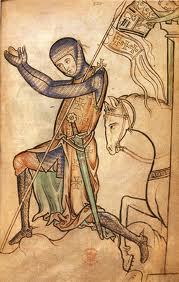 Least impacted by circumstances and so least unique were the armor and arms of the military elite. The armor and weapons of Western knights had proved superior to the protective armor and weapons of the Saracens from the time of the First Crusade. That fundamental advantage continued throughout the period of Latin rule in the eastern Mediterranean. This is not to say that there was no development. On the contrary, arms and armor underwent dramatic changes in the two hundred years from 1099 to 1291, and again before the fall of Cyprus to Venice in 1473. The evolution of arms and armor, however, was common to the entire West, with local variation to be sure, but any major innovation that provided significant advantages was rapidly adopted by a ruling elite that was remarkably mobile given the means of transportation.
Least impacted by circumstances and so least unique were the armor and arms of the military elite. The armor and weapons of Western knights had proved superior to the protective armor and weapons of the Saracens from the time of the First Crusade. That fundamental advantage continued throughout the period of Latin rule in the eastern Mediterranean. This is not to say that there was no development. On the contrary, arms and armor underwent dramatic changes in the two hundred years from 1099 to 1291, and again before the fall of Cyprus to Venice in 1473. The evolution of arms and armor, however, was common to the entire West, with local variation to be sure, but any major innovation that provided significant advantages was rapidly adopted by a ruling elite that was remarkably mobile given the means of transportation. There was, however, one innovation which is widely attributed to crusading, and this was the evolution of the “surcoat” a cloth garment worn over armor. The argument for attributing the emergence of the surcoat in the 12th century is that fighting in the intense sun of the Middle East would have made chainmail dangerously hot; by covering it with a thin, loose and flowing cloth, however, the chainmail could be kept comparatively cool. With the surcoat came the opportunity to wear colors and so also to wear distinguishing devices or “arms” as well. Hence the evolution of heraldry goes hand-in-hand with the emergence of the surcoat as an integral part of a knight’s battle dress.
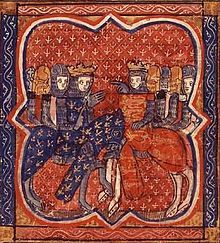
Off the battlefield, the men of Outremer may have been tempted to adapt some of the clothing customs of native inhabitants. It seems logical (at least to us) that at least during the hot summer months, men at leisure might have preferred loose flowing robes to hose, padded garments such as gambesons, much less fur-lined cloaks and hoods. There is, however, little to no evidence to support this. The depictions of barons and knights in manuscripts, sculpture or seals consistently show men of the military elite in military regalia. Kings are often depicted in voluminous robes, but these are identical to the robes of kings from the West. This has led some scholars to suggest that it was a matter of class pride not to adapt the fashions of the natives. Such an interpretation, however, is more consistent with earlier assumptions about “colonial” attitudes than recent evidence of inter-marriage and close cooperation with native Christian elites. In short, we do not know how the men of Outremer dressed “off-duty” and in private settings.
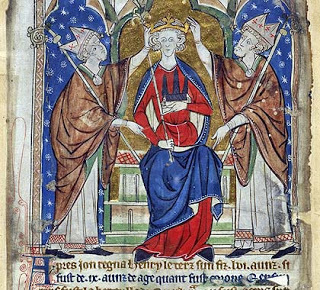
We know even less about what the women in the crusader states wore. They are depicted less frequently in art, and if so almost always in conventional Western garb. We know for certain that they did not adopt Muslim customs of going about completely veiled. The evidence for this comes from Muslim sources that both decry the lack of “modesty” displayed by crusader women―and admire the allure of women so exposed to the eyes of strange males. That said, I also suspect that women will have found some means of protecting their skin from the ravages of the Middle Eastern sun, and this may have included veils worn over their faces while out of doors. Or it may have entailed wide-brimmed hats that cast a shadow. Yet both ideas are pure speculation.
Furthermore, although the style of clothing may not have differed significantly from what was the latest fashion in Paris, Cologne, Pisa and Rome, the materials used could have made a significant difference to the effectof the clothes. The same surcoat or gown will fall, fold, billow and sway differently if made of heavy woolen or stiff linen compared to cotton gauze or silk. Many of the fabrics of Outremer were sheer, translucent or semi-transparent. Depending on how such fabrics are employed, they could have created enticingly provocative (or in the eye of clerics and conservatives vulgar and immodest) garments without ever deviating from the fashions wore in London or Paris. Likewise, a gown that is simple in cut and form can be transformed by silk brocade or a weft of gold into something stunning, luxurious and so (depending on your ideology) something self-indulgent and extravagant.
 Isabella of Jerusalem is shown here wearing "cloth of gold."
Isabella of Jerusalem is shown here wearing "cloth of gold." Archaeologists have uncovered thousands of fabric fragments dating to the crusader era. While it is impossible to know if these were locally produced or imported, used by natives or the Latin elites, they do demonstrate the variety of textiles available. They included silk, cotton, linen, felt, wool, and cloth woven from goat hair. They also include a large number of hybrid fabrics composed of a warp of one kind of yarn and weft of another, such as silk and wool, linen or cotton.
We also know for a fact that some of the finest cloth known to the medieval world originated in the Near East. Egyptian cotton and linen, both renowned for their quality, were exported through the ports of the Levant as was silk from Damascus. Words familiar to us as types of cloth such as muslin, gauze, and damask derive their names from the cities that first produced them in export quantities, namely Mosul, Gaza and Damascus. Other fabrics no longer in use, such as siqlatin (silk woven with gold), were also known to have been traded through the ports of the crusader states and so were certainly in use there.
Nor did these textiles just pass through the ports of Outremer. There is documentary and archaeological evidence that textiles were produced in the crusader states. There were, for example, some 4,000 silk weavers in the County of Tripoli. Tyre was famous for its white silk. Beirut exported both silk and cotton fabrics, while cotton was grown around Acre, Tiberias and Ramla.
Almost as important as the material from which clothes were made are the dyes used to color it. Here again, the crusader states sat near the source of many materials coveted for dying. Saffron, turmeric, and indigo ― not to mention the muscles found only off Tyre and the Peloponnese needed for a rich purple dye ― were all more readily available and cheaper in the crusader states than in Western Europe. This makes it probable that they were used more widely and more generously used, producing much brighter colors than was common in the west.
And then comes the decoration. Weaving with different color threads, block printing and embroidery were all means of creating patterns and prints on the cloth fragments from this period. Silk brocade and stitching with spun gold were particularly expensive and coveted forms of decoration for clothing that are known to have been exported, if not produced, in the crusader states.
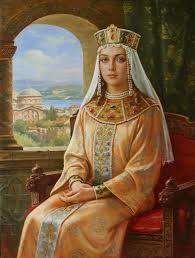 Byzantine fashions influenced the crusaders more than Arab fashion. Note the elaborate decoration and the silk brocade used for the gown itself.
Byzantine fashions influenced the crusaders more than Arab fashion. Note the elaborate decoration and the silk brocade used for the gown itself. It was probably the combination of fine cloth and the use of vivid colors in decoration that made the clothing of Latin elites in Outremer seem exotic to visitors from the West. It was often commented upon by crusaders that the lords of Outremer were very rich and luxury loving. Some of that reputation came from a proclivity for bathing, and the use of sweet scents and perfume, but some was undoubtedly the apparent extravagance of dress that came from being able to afford for everyday materials that in the West were saved only for special occasions.
Daily life, including clothes and fashion, is depicted as accurately as possible in my novels set in Outremer:


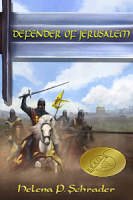
Buy now! Buy now! Buy now!
Published on May 20, 2017 23:25
May 14, 2017
Life and Lifestyle in the Crusader Kingdoms: Domestic Architecture
The way we build our homes both reflects and shapes our lives. Thus the lay-out of homes reveals a great deal about the society in which they were built. Was collective living or privacy preferred? Was light or security more important? Was luxury or convenience given precedence?As a novelist, it is impossible to evoke a bygone age or to depict a period effectively without knowing how the homes of characters were built and how they functioned.
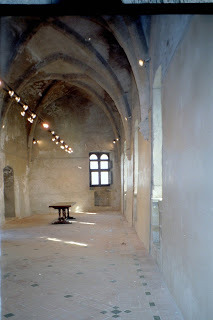
The Bishop of Oldenburg, traveling to the Kingdom of Jerusalem in 1212, was stunned by the luxury of the residences of the elite. According to Sir Steven Runciman in his "Families of Outremer," Oldenburg was particularly impressed by the Ibelin palace in Beirut:
Its windows opened some on the sea, some on to delicious gardens. Its walls were paneled with plaques of poly-chrome marble; the vaulted ceiling [of the salon] was painted to resemble the sky with its stars; in the center of the [salon] was a fountain, and round it mosaics depicting the waves of the sea edged with sands so lifelike that [the bishop] feared to tread on them lest he should leave a foot mark.Unfortunately, nothing of this palace remains today.
The same is true of the Lusignan palace in Nicosia, but Volume 4 of A History of the Crusades: The Art and Architecture of the Crusader States, Hazard, Harry W ed. provides the following summary:
The royal palace, adjoining the church of St. Dominic, seemed to travelers the finest in the world. Its great throne room, its balconies, its golden ornaments, its tapestries, pictures, organs, and clocks, its baths, gardens and menageries suggest the most sumptuous of medieval residences. (p. 175)While both the above passages refer to palaces (baronial and royal respectively), the following is a more general commentary on Frankish domestic architecture in the crusader states. Writing after the re-conquest of Jerusalem by Saladin in 1187, Ibn-Khallikan wrote:
"the infidel had rebuilt [Jerusalem] with columns and plaques of marble...with fair fountains where the water never ceased to flow--one saw dwellings as agreeable as gardens and brilliant with the whiteness of marble; the columns with their foliage seemed like trees." (quoted in Hazard, p. 138.)Yet only scattered fragments of this sophisticated urban secular architecture from the crusader period have survived into the present. Even these remains have largely been obscured by the changing styles and functions of that altered the appearance of crusader structures almost beyond recognition in subsequent centuries.
However, descriptions such as those cited above as well as systematic analysis of the archeological evidence enables us to imagine a great deal. As a novelist writing about the crusader kingdoms, I am compelled to utilize all existing sources, both written and archaeological — and then add a hefty dose of imagination. What follows is a short survey of the key elements that would have defined an urban dwelling in the crusader kingdoms.
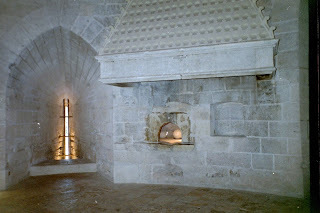 Due to a general scarcity of wood, the basic building material in the Middle East in the crusader period was stone and/or brick. The latter, and often the former, was plastered over and whitewashed, both inside and out, or faced with marble in the case of important and representational buildings. The floors of poorer dwellings were either beaten earth or cut out of the bedrock, while upper floors were plaster. In wealthier homes the floors were usually flagstone on the ground floor, marble or mosaic. Courtyards were usually paved with cobbles.
Due to a general scarcity of wood, the basic building material in the Middle East in the crusader period was stone and/or brick. The latter, and often the former, was plastered over and whitewashed, both inside and out, or faced with marble in the case of important and representational buildings. The floors of poorer dwellings were either beaten earth or cut out of the bedrock, while upper floors were plaster. In wealthier homes the floors were usually flagstone on the ground floor, marble or mosaic. Courtyards were usually paved with cobbles.The basic building block of houses in the Holy Land were vaults. Barrel vaults were the easiest and most fundamental building block and could be stacked on top of one another at perpendicular angles for several stories. A good example of this is the Hospitaller Castle of Kolossi. Below are three images of vaulted chambers: one an upstairs chamber from the Hospitaller castle at Kolossi, one a cellar from the Byzantine/Crusader castle of St. Hilarion, and the third showing a wine or oil press in the ground-floor chamber, something very common in the crusader kingdoms.
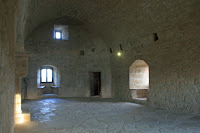
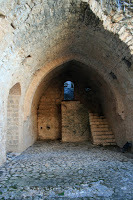
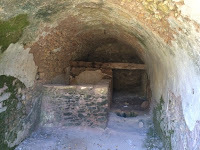
Groin vaults and rib-vaults, however, was also common, particularly in larger structures such as palaces, monasteries, customs houses, and the like. Here is an image of beautiful vaulting from Bellapais Monastery on Cyprus.
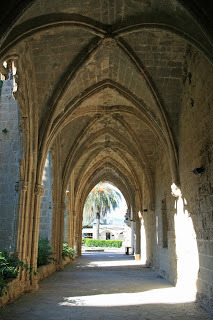
Most houses in the crusader states appear to have had at least one, and in urban areas -- particularly in the 13th century -- as many as three upper floors. The upper floors were often reached by means of an external stairway over a arch (see photo below), or by means of internal wooden stairs or even ladders through trap doors. In larger, rural structures, stairs could also be built into the thickness of the walls. The house below, located on Kythera, is much younger (17th century Venetian), but it has many of the features of crusader urban architecture.
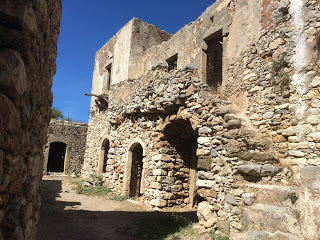 Most buildings in the Middle East were crowned, then as now, by flat roofs (that might be decoratively crenelated) that often provided additional living or work space in the form of a roof-top terrace that could be shaded from the sun by canvas awnings, or a vine arbor.
Most buildings in the Middle East were crowned, then as now, by flat roofs (that might be decoratively crenelated) that often provided additional living or work space in the form of a roof-top terrace that could be shaded from the sun by canvas awnings, or a vine arbor. Whether used as a terraceor not, rooftops almost always collected rain water in a cistern. Indeed, even the poorest and smallest of urban dwellings had cisterns, often several. All had settlement tanks to help purify the water. Water could be pumped from these tanks to the kitchens or latrines.
Many urban dwellings would have been built around one or a series of courtyards. These in turn contained cisterns or sometimes wells, kitchen and formal gardens, or working space, depending on the wealth of the occupant. The courtyard below in Jerusalem has many medieval elements and does not look so very different from what it could have looked like in the 12th century.
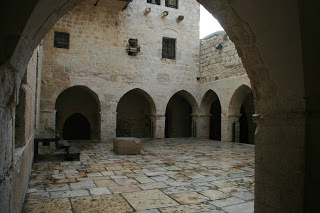
The courtyard in the next photo is from the Hospitaller headquarters in Acre. It is an example of a more spectacular, 13th century courtyard and only relevant for public buildings, but it is indicative of style, taste and crusader capabilities.
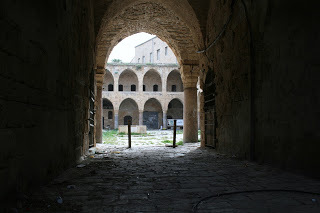
Poorer residents, who could no afford a house large enough to surround one or more courtyards often shared a communal courtyard. Around a courtyard, several dwellings were clustered, all with access to the common courtyard.
Despite the prevalence of courtyards, Frankish houses were not inward-looking. Unlike their Arab contemporaries, the houses of the rich had beautiful balconies and logias that looked out over the streets from the upper stories. The roof of the logia in urban areas might be supported either by an arcade or by pillars. Some of these pillars were reclaimed Roman pillars, employed in a new function, but the Franks were skilled at producing pillars themselves and the capitals of these were famous -- even among their enemies -- for the lifelike quality of their decoration. In rural settings the logia could be even more dramatic as in the example below from St. Hilarion on Cyprus.
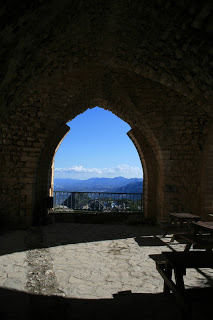
The working class on the other hand had workshops and store fronts that opened onto the street at ground level.
Doors throughout the Frankish territories from the mid-12th century until the end of Frankish rule were usually made by a wide, slightly pointed arch. This arch, borrowed from the Arabs before the beginning of true Gothic architecture in the West, was the dominant, indeed iconic, shape of crusader architecture. Poorer dwellings or secondary doors, however, could be square.
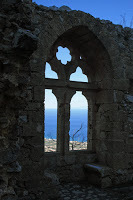
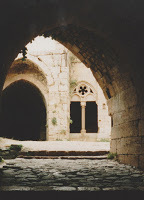
Windows could be either arched or square, with the Romanesque forms of “double-” or “triple-light” windows as common in the Holy Land as in the countries of the crusaders’ origin. Below is a lovely example of a medieval portal in Jerusalem, and left and right are two examples of windows from St. Hilarion and Krak de Chevaliers respectively.
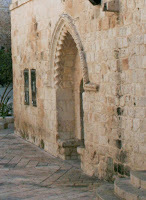
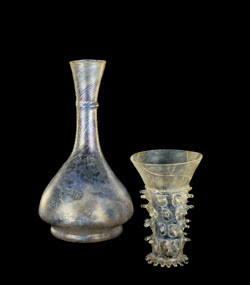 Because there were major glass producing centers in the crusader states (notably Tyre and Beirut), window glazing was more common in the crusader states than in the West, a fact supported by both archaeological finds and descriptions. Right is an example of crusader glass manufacture. While the context is different, this glass demonstrates the very high quality of the industry generally.
Because there were major glass producing centers in the crusader states (notably Tyre and Beirut), window glazing was more common in the crusader states than in the West, a fact supported by both archaeological finds and descriptions. Right is an example of crusader glass manufacture. While the context is different, this glass demonstrates the very high quality of the industry generally.Archaeological evidence suggests the Franks used both plate glass and round glass set in plaster (the latter being presumably much cheaper and more common) for their windows. Below is an example of the round glass technique used here in the Templar Church in Famagusta, Cyprus.
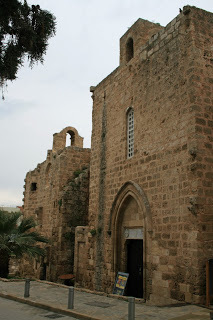
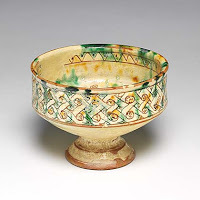
As the description at the start of this essay indicated, interior décor could include poly-chrome marble, but mosaics and glazed tiles may also have been used. Certainly, a wide variety of crusader glazed pottery has been found, using cream colors, yellows, greens and blues. The pottery gives us some indication of what colors and motifs could have been used on floor and wall tiles, although the evidence is lacking. To the right is an example of crusader pottery.
However, we also know that the Turks and Saracens were very fond of brilliant blues and turquoise tiles in later centuries, and these may also have been available to the crusaders. At least I like to imagine it so! Below is an example of modern tile work just to hint at the possibilities.
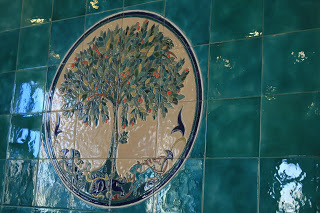 As for mosaics, the description at the start of the article is perhaps the best indication of quality and the fact that life-like motifs were possible in the crusader era. However, we should not forget that mosaics floors were very common in the Roman and Byzantine periods, and the many crusader residences in fact dated from earlier periods and retained these older tiles. Below is a picture of tiles that date back the 4th century AD and were allegedly commission by St. Helena. Particularly under the influence of the Byzantine brides of Baldwin III and Amalric I, Byzantine styles and artists were welcomed and employed in the crusader kingdoms. They would easily have produced tiles similar to this example from the Church of the Nativity in Bethlehem.
As for mosaics, the description at the start of the article is perhaps the best indication of quality and the fact that life-like motifs were possible in the crusader era. However, we should not forget that mosaics floors were very common in the Roman and Byzantine periods, and the many crusader residences in fact dated from earlier periods and retained these older tiles. Below is a picture of tiles that date back the 4th century AD and were allegedly commission by St. Helena. Particularly under the influence of the Byzantine brides of Baldwin III and Amalric I, Byzantine styles and artists were welcomed and employed in the crusader kingdoms. They would easily have produced tiles similar to this example from the Church of the Nativity in Bethlehem.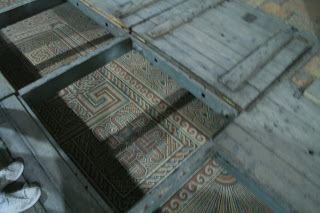
Last but not least, as the contemporary written descriptions stress, no description of urban architecture in the crusader states (at least for the “upper crust”) would be complete without reference to gardens. Frankish elites oriented their houses so that their (glazed) windows looked out at either views (such as the ocean) or gardens. The Holy Land offered a variety of beautiful vegetation from trees such a palms and olives, lemons and pomegranates, to flowers such as hibiscus and oleander. Frankish gardens would have been beautiful indeed. So to conclude, here is a picture of a garden in the crusader church of St. Anne in Jerusalem today.

Note: All photos except the glass and pottery were taken by the author.
Recommended reading: Andrian Boas' Domestic Settings: Sources on Domestic Architecture and Day-to-Day Activities in the Crusader States, Brill, 2010.
Life in the crusader kingdoms is described in my three part biography of Balian d’Ibelin:



Buy now! Buy now! Buy now!
Published on May 14, 2017 00:40
May 6, 2017
Writing Biographical Fiction: Saladin
I'd like to close this series on Writing Biographical Fiction with a look at one of the most challenging characters I had to deal with: the heroic and famous Sultan Salah ad-Din, known in the west as Saladin.
 When writing about Saladin in a novel one is always confronted by the fact that he has long been viewed as the epitome of Saracen “chivalry.” Indeed, in the last century it became common to suggest that, while the crusaders were treacherous barbarians, Saladin stood out as a paragon of virtue and honor, a shining light of decency and chivalry in an otherwise brutal age. This is the view of Saladin that dictated the highly sympathetic portrayal in Ridley Scott's film “The Kingdom of Heaven.” It is the image that dominates the mind of most readers coming to a book about the crusades.
When writing about Saladin in a novel one is always confronted by the fact that he has long been viewed as the epitome of Saracen “chivalry.” Indeed, in the last century it became common to suggest that, while the crusaders were treacherous barbarians, Saladin stood out as a paragon of virtue and honor, a shining light of decency and chivalry in an otherwise brutal age. This is the view of Saladin that dictated the highly sympathetic portrayal in Ridley Scott's film “The Kingdom of Heaven.” It is the image that dominates the mind of most readers coming to a book about the crusades.
Yet, as Andrew Ehrenkreutz catalogues in his meticulously documented and detailed biography of Saladin published in 1972, Saladin frequently used deceit, hypocrisy, propaganda, bribery, extortion, murder and, ultimately aggressive war to establish an empire in the Near East. Ehrenkreutz also notes that Saladin spent much more time and money fighting (and killing) fellow Muslims than he did fighting Christians; Saladin was responsible for the loss of many more Sunni Muslim lives than Christian ones.
A depiction of Saladin based on Ehrenkreutz would be too extreme -- and certainly too much to swallow for readers raised on the Kingdom-of-Heaven Saladin. That isn't what I wanted. However, it was important to me that I didn’t simply serve up the legend without any acknowledgement of historical reality. Thus, in developing the Saladin of my novels, I sought to balance the two views of Saladin and focus on portraying him not as “good” or “bad” but rather as a highly effective political leader. I wanted a “worthy adversary,” for Balian and the crusader states, but not one who was a caricature of either virtue or villainy. I sought to create a man who was ambitious and ruthless in attaining and maintaining power, but also capable of generosity and magnanimity -- when it did not run contrary to his interests. Likewise, I sought to explain Saladin’s behavior by analyzing possible motives.
A particularly good example of this is the famous instance in which Saladin gave Balian d’Ibelin a safe-conduct to cross Saracen-held territory to enter Jerusalem and remove his wife and family after the Battle of Hattin but before the fall of Jerusalem. Not only was this a magnanimous gesture to a Christian lord and a foe, it was topped by Saladin sending some of his own personal body-guard to escort the Lady of Ibelin to safety after her husband broke his word, and — ceding to immense pressure from the Christian population in Jerusalem — agreed to take command of the defense of the Holy City. But the “chivalrous” character of these gestures is somewhat mitigated by the fact that the Lady of Ibelin was also a Byzantine princess and a relation of the ruling Greek Emperor Isaac II Angelus, with whom Saladin had just concluded a treaty of alliance. It was still a generous gesture since Maria Comnena, Lady of Ibelin, was not a close relative of Isaac II, but Saladin’s decision was certainly salted with a pinch of self-interest.
Equally important to me in my portrayal of Saladin was his unbending hostility to Christianity and his commitment to jihad. This has nothing to do with whether Saladin was “good” or “bad” (I’m not trying to make him a medieval ISIS leader), but it is essential to understanding what options were available to the Christian leaders. It is, as Israeli governments can testify, impossible to make peace with people who do not recognize your right to exist. Too many histories and novels are written on the premise that the crusader states could have co-existed with their Muslim neighbors indefinitely. This is simply not logical. Jihadist Islam requires good Muslims to spread the religion ― including by the sword ― and recognizes the right of select other religions to live under Islamic rule only under humiliating and burdensome conditions.
Last but not least, the Saladin of my novels is a man of his age and culture, and I have drawn on Arab chronicles and Islamic writings to depict his probable attitudes toward, above all, women. Muslims in this period found the presence of women in public life (such as queens, castellans etc.) not only incomprehensible but disgusting. The very fact that women had names and faces known outside of the family circle was viewed as immoral and dishonorable. The fact that women had a voice in political affairs, could control wealth, influence politics, and even command men was even more offensive. The differing attitudes toward women was one of the most crucial differences between Christendom and Islam in the 12thcentury. As a novelist with strong female characters, it would be nothing short of negligent not to highlight this fact.
Likewise, the dependence of 12th century Syria and Egypt on slaves is fact that I had no wish to gloss over or ignore. Particularly in the third book of the series, the contemporary attitudes toward slavery is an important issue and plot-line. Although I use the historical figure Imad ad-Din most directly to address this theme, quoting directly from his own works, Saladin too is consciously used as a representative of the world from which he came. In this sense, Saladin in my novels is both a character and a symbol ― but then so is Balian.
Saladin plays a significant role in the second two books of the Jerusalem trilogy.



Buy now! Buy now! Buy now!
 When writing about Saladin in a novel one is always confronted by the fact that he has long been viewed as the epitome of Saracen “chivalry.” Indeed, in the last century it became common to suggest that, while the crusaders were treacherous barbarians, Saladin stood out as a paragon of virtue and honor, a shining light of decency and chivalry in an otherwise brutal age. This is the view of Saladin that dictated the highly sympathetic portrayal in Ridley Scott's film “The Kingdom of Heaven.” It is the image that dominates the mind of most readers coming to a book about the crusades.
When writing about Saladin in a novel one is always confronted by the fact that he has long been viewed as the epitome of Saracen “chivalry.” Indeed, in the last century it became common to suggest that, while the crusaders were treacherous barbarians, Saladin stood out as a paragon of virtue and honor, a shining light of decency and chivalry in an otherwise brutal age. This is the view of Saladin that dictated the highly sympathetic portrayal in Ridley Scott's film “The Kingdom of Heaven.” It is the image that dominates the mind of most readers coming to a book about the crusades.Yet, as Andrew Ehrenkreutz catalogues in his meticulously documented and detailed biography of Saladin published in 1972, Saladin frequently used deceit, hypocrisy, propaganda, bribery, extortion, murder and, ultimately aggressive war to establish an empire in the Near East. Ehrenkreutz also notes that Saladin spent much more time and money fighting (and killing) fellow Muslims than he did fighting Christians; Saladin was responsible for the loss of many more Sunni Muslim lives than Christian ones.
A depiction of Saladin based on Ehrenkreutz would be too extreme -- and certainly too much to swallow for readers raised on the Kingdom-of-Heaven Saladin. That isn't what I wanted. However, it was important to me that I didn’t simply serve up the legend without any acknowledgement of historical reality. Thus, in developing the Saladin of my novels, I sought to balance the two views of Saladin and focus on portraying him not as “good” or “bad” but rather as a highly effective political leader. I wanted a “worthy adversary,” for Balian and the crusader states, but not one who was a caricature of either virtue or villainy. I sought to create a man who was ambitious and ruthless in attaining and maintaining power, but also capable of generosity and magnanimity -- when it did not run contrary to his interests. Likewise, I sought to explain Saladin’s behavior by analyzing possible motives.
A particularly good example of this is the famous instance in which Saladin gave Balian d’Ibelin a safe-conduct to cross Saracen-held territory to enter Jerusalem and remove his wife and family after the Battle of Hattin but before the fall of Jerusalem. Not only was this a magnanimous gesture to a Christian lord and a foe, it was topped by Saladin sending some of his own personal body-guard to escort the Lady of Ibelin to safety after her husband broke his word, and — ceding to immense pressure from the Christian population in Jerusalem — agreed to take command of the defense of the Holy City. But the “chivalrous” character of these gestures is somewhat mitigated by the fact that the Lady of Ibelin was also a Byzantine princess and a relation of the ruling Greek Emperor Isaac II Angelus, with whom Saladin had just concluded a treaty of alliance. It was still a generous gesture since Maria Comnena, Lady of Ibelin, was not a close relative of Isaac II, but Saladin’s decision was certainly salted with a pinch of self-interest.
Equally important to me in my portrayal of Saladin was his unbending hostility to Christianity and his commitment to jihad. This has nothing to do with whether Saladin was “good” or “bad” (I’m not trying to make him a medieval ISIS leader), but it is essential to understanding what options were available to the Christian leaders. It is, as Israeli governments can testify, impossible to make peace with people who do not recognize your right to exist. Too many histories and novels are written on the premise that the crusader states could have co-existed with their Muslim neighbors indefinitely. This is simply not logical. Jihadist Islam requires good Muslims to spread the religion ― including by the sword ― and recognizes the right of select other religions to live under Islamic rule only under humiliating and burdensome conditions.
Last but not least, the Saladin of my novels is a man of his age and culture, and I have drawn on Arab chronicles and Islamic writings to depict his probable attitudes toward, above all, women. Muslims in this period found the presence of women in public life (such as queens, castellans etc.) not only incomprehensible but disgusting. The very fact that women had names and faces known outside of the family circle was viewed as immoral and dishonorable. The fact that women had a voice in political affairs, could control wealth, influence politics, and even command men was even more offensive. The differing attitudes toward women was one of the most crucial differences between Christendom and Islam in the 12thcentury. As a novelist with strong female characters, it would be nothing short of negligent not to highlight this fact.
Likewise, the dependence of 12th century Syria and Egypt on slaves is fact that I had no wish to gloss over or ignore. Particularly in the third book of the series, the contemporary attitudes toward slavery is an important issue and plot-line. Although I use the historical figure Imad ad-Din most directly to address this theme, quoting directly from his own works, Saladin too is consciously used as a representative of the world from which he came. In this sense, Saladin in my novels is both a character and a symbol ― but then so is Balian.
Saladin plays a significant role in the second two books of the Jerusalem trilogy.



Buy now! Buy now! Buy now!
Published on May 06, 2017 01:00
April 29, 2017
Writing Biographical Fiction: Conrad de Montferrat
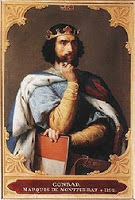 19th Century Depiction of Conrad de MontferratOf all the historical characters in my Jerusalem trilogy, Conrad de Montferrat is the one other writers unanimously paint as the villain par excellance. Even Andrew Latham, an otherwise meticulously accurate historian, found it convenient to cast Montferrat as a diabolic evil monster obsessed with this own power in The Holy Lance.
19th Century Depiction of Conrad de MontferratOf all the historical characters in my Jerusalem trilogy, Conrad de Montferrat is the one other writers unanimously paint as the villain par excellance. Even Andrew Latham, an otherwise meticulously accurate historian, found it convenient to cast Montferrat as a diabolic evil monster obsessed with this own power in The Holy Lance. It’s easy for novelists to fall into the cliché because one of the surviving primary sources, Itinerarium Peregrinorum et Gesta Regis Ricardi, delights in heaping abuse on the man who dared to defy Richard the Lionheart. The Montferrat of English legend, therefore, was a man who shot a cross-bow at his own father, killed his doctors, abducted a princess, bribed bishops, intentionally withheld food from crusaders, undermined all efforts by Richard of England to defeat Saladin, and finally met his just end at the hands of an assassin. It would have been easy to follow the tradition of making Montferrat into a sort of medieval Darth Vader.
But I don’t like cartoon characters in my novels. I wanted a more nuanced and comprehensible man for my books. Turning to less biased, particularly German sources, I discovered what I was looking for: a man of “many parts” with a wealth of positive characteristics and achievements to balance the negative portrayal of the Itinerarium.
Conrad de Montferrat, born about 1145, was a first cousin of Emperor Friedrich Barbarossa and of the French King. His older brother, William, married Sibylla of Jerusalem. Conrad’s younger brother, Rainier married Maria Comnena, the daughter of Emperor Manuel I. In short, Conrad de Monteferrat was closely related to the Holy Roman Emperor, the Emperor of the Eastern Roman (Byzantine) Empire, the King of France, and the ruling Queen of Jerusalem. Conrad de Montferrat was not — as some modern novelists would have you believe — an “adventurer” or a parvenu.
Furthermore, Conrad was a very well-educated, well-traveled and militarily experienced nobleman. He supported his father in his wars and in 1179 prominently defeated the forces of the Holy Roman Emperor taking the Imperial chancellor captive. He subsequently went to Constantinople, where he was greatly admired for his good looks, charm and military prowess. Although he wisely departed Constantinople after Emperor Manuel I's death -- and shortly before his younger brother and sister-in-law were murdered by the usurping Emperor Andronicus, at the invitation of Emperor Isaac Angelus Conrad returned in 1186 to marry the Emperor’s sister Theodora. Conrad was raised to the rank of “Caesar,” and put down a rebellion led by the popular general Alexios Branas in a battle where he demonstrated exceptional personal courage. His success led his brother-in-law to look on him with jealousy and suspicion, however, and Conrad soon feared for his life (his brother, after all, had been murdered in Constantinople only five years earlier). He fled Constantinople, and took ship for the Kingdom of Jerusalem, arriving there only days after the catastrophe of Hattin.
Conrad sailed into the harbor at Tyrewhen it was already invested by land by the Sultan’s army. Negotiations for the surrender were allegedly already underway, whether as a ruse or in earnest. Conrad immediately and forcefully advocated defiance. With so many other cities ripe for surrender, Saladin chose not to fight for Tyre, but withdrew to capture Sidon, Beirut, Caesarea, Jaffa, etc. Meanwhile, the people of Tyre, which included not only the usual residents but the survivors of Hattin and refuges from across the north of the Kingdom of Jerusalem, swore allegiance to Montferrat.
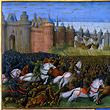
When Saladin returned to finish off Tyre in November 1187, he brought with him Conrad’s father, the aging Marquis de Montferrat, who had fought and been taken captive at Hattin. Saladin offered to release the Marquis in exchange for the surrender of Tyre. The chronicles tell a dramatic tale in which Conrad pointedly refused the deal, saying his father had “lived long enough already” and fired a crossbow in his direction (probably intended to miss or to kill one of his Saracen escort). Much has been made of this as proof of Conrad’s perfidy or callousness. Yet, the chronicles agree that Conrad’s father called out something to the effect of “well done” when Conrad refused to surrender. The old Marquis of Montferrat, who had fought long and hard for the Holy Land, did not want to see the last remaining bastion of the kingdom surrendered. I found myself liking Conrad for his iron nerves!
In addition to the old Marquis, Saladin had brought another means for reducing the city: the Egyptian fleet. Tyre was now truly besieged and crammed as it was with refugees and cut off from resupply the situation rapidly became critical. Montferrat devised a trick: he led the enemy to believe that people were rioting and some of the wealthier residents were going to attempt a breakout. The chain across the harbor entrance was lowered as if to let the ships escape. The Saracens took the bait. They shot into the harbor, thinking they were about to take the city by the back door. Instead, they found themselves attacked by the Pisan vessels in the harbor and fired on from the surrounding walls, towers and buildings. The very next day, January 1, 1188, Saladin ordered his army to disperse and withdrew.
All of the above reflects well on Conrad de Montferrat’s capabilities as a determined, resourceful, and clever commander. But it was his political actions that generally draw approbation and they started a year and a half later when, out of the north, a small Frankish army led by none other than the architect of the disaster at Hattin, Guy de Lusignan, appeared before the gates of Tyre. King Guy ordered the gates of the last free city of his kingdom opened to him. Conrad de Montferrat refused. Again, I can’t say that I blame him.
Guy continued south to lay siege to Acre, which was now held by a Saracen garrison. Thus, when the crusaders started to arrive in increasing numbers in 1190 and 1191 most of them joined the siege of Acre because it was the only active fighting available. While this should have increased Guy de Lusignan’s stature, in fact, the arriving contingents of troops tended to recognize their own leaders rather than Guy. Then in November 1190 Guy’s position was fatally undermined by the death of his wife and both his daughters. Guy, always unpopular, widely viewed by the barons of Jerusalem as a usurper, and discredited by Hattin, lost his last vestige of legitimacy with his wife’s death. The High Court of Jerusalem recognized Sibylla’s younger sister Isabella as the rightful ruler of Jerusalem after Sibylla’s death.
Only there was a problem. The Constitution of Jerusalem recognized the rights of women to rule in their own right, but only if they had a male consort capable of leading the army of Jerusalem. Isabella’s husband Humphrey de Toron had already betrayed the High Court when the High Court was trying to oppose Guy’s usurpation of the throne in 1186. The High Court was not prepared to recognize Humphrey as king. That meant that Isabella had to be separated from him and married to a man more acceptable to the barons of Jerusalem. The details of this are described in The Abduction of Isabella. For now suffice it to say that Conrad was the man they chose.
The Itinerariumand most subsequent sources portray Conrad as the driving force behind his marriage to Isabella. He is described as scheming and bribing, as unscrupulous and duplicitous. These portrayals, however, completely ignore the essential fact that it was the High Court of Jerusalem that decided on the marriage of a female heir and the fact that the High Court consistently supported Conrad over Guy. The overblown outrage of the chronicles likewise obscures the plain fact that Isabella was below the age of consent at the time of her marriage to Humphrey (she was 11) and the marriage was without question invalid according to contemporary canon law. While it is also highly probable that Conrad was ambitious and coveted the crown, it is absurd to portray his marriage to Isabella as a travesty of justice or an act of moral depravity. In my novel, therefore, I emphasize the role of the High Court, while nevertheless depicting Conrad as very ambitious and eager to gain the favor of the High Court.

By the time the Kings of France and England arrived in the Holy Land, there were two rival claimants to the (largely fictional) throne of Jerusalem: 1) Conrad, supported by the High Court and deriving his claim through the legitimate heir, Isabella, and 2) Guy, clinging to the title he had from his now dead wife because he’d been crowned and anointed. Their rivalry immediately became a proxy war between Philip II of France, who backed his kinsman Conrad, and Richard I of England, who backed his vassal Guy. Unfortunately for Conrad, Philip II soon tired of crusading and sailed away, while Richard I remained and recaptured much of the fertile coastal plain although he was unable to regain Jerusalem. In my novels, it is this conflict that initially puts Balian and Richard on opposing sides and so in conflict with one another.
During the critical eleven months from October 1191 to September 1192, Richard I periodically sought a negotiated settlement with Saladin. Not surprisingly, Conrad feared that Richard would negotiate a deal that left him high and dry, and so he tried to cut a deal of his own. This has been portrayed as the height of infamy by the supporters of Richard, but it is hard to see why it was legitimate for Richard to negotiate with Saladin but not for Conrad. Saladin, meanwhile, had a strong interest in playing Conrad and Richard off against one another and sowing dissension in the Frankish camp. However, it appears that Conrad was so desperate (or determined) to get a little kingdom (or county) of his own that he was prepared to fight his fellow Christians, and this seemed to me very telling. Conrad was resourceful, brave, and clever, but he was also ruthlessly ambitious.
In fashioning the Conrad de Montferrat of my novel Envoy of Jerusalem I tried to do justice to him as a complex character full of charm, ambition, talent -- and opportunism. I believe he would have used his charm very judiciously and intelligently to win over the heiress of Jerusalem – even before the succession crisis. She was after all, a guest in “his” city of Tyre, which makes my version of events diverge from the usual portrayal of Isabella as abducted and abused by a man she hates. His ambition and talent are depicted in his defense of Tyre, his refusal to admit Guy, and bid his for the crown. However, on the assumption that a man with so many enemies was not always pleasant and congenial, I have also made him arrogant, self-willed, immune to advice and at times unscrupulous.
The Conrad de Montferrat is a major character in Envoy of Jerusalem.
 Buy now in paperback or Kindle!
Buy now in paperback or Kindle!
Published on April 29, 2017 23:00
April 22, 2017
Writing Biographical Fiction: Humphrey de Toron
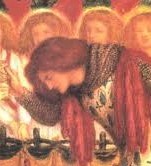 The historical Humphrey de Toron is known mostly for what he lost. He lost his fief, his wife, and his freedom; he surrendered the most powerful border castles of Kerak and Montreal to Saladin--and he rejected a crown. Having lost everything to which he had been entitled by birth and marriage, he fades from the pages of history to die in an unknown place at an unknown date, without ever having sired children.
The historical Humphrey de Toron is known mostly for what he lost. He lost his fief, his wife, and his freedom; he surrendered the most powerful border castles of Kerak and Montreal to Saladin--and he rejected a crown. Having lost everything to which he had been entitled by birth and marriage, he fades from the pages of history to die in an unknown place at an unknown date, without ever having sired children. That would be tragic in itself, but what puts Humphrey on the brink of pathetic is that he was very much to blame for most of these losses. A man of different character might have been the founder of a dynasty, rather than an obscure footnote in history. In creating my fictional Humphrey de Toron, therefore, I was very much looking for an explanation of why Humphrey was the way he was. I had a major hint: contemporary accounts of him call him “cowardly and effeminate,” or “more like a woman than a man.” He was said to be very learned, and to have “a gentle manner and a stammer.”
Why would the heir to of one of the greatest barons of Jerusalem, Humphrey de Toron II, be so “cowardly and effeminate?
Humphrey de Toron II (the grandfather of my character) had not only been the lord of the important fief of Toron, he was Constable of the Kingdom of Jerusalem from 1153 to 1179. Toron owed 18 knights to the crown, making it a mid-sized barony by man-power, but it held two great castles, Toron itself and Castel Neuf on the border with Syria east of Tyre. Furthermore, Constable was not an empty title at this time, but brought with it the duty to muster and command the feudal armies. Humphrey de Toron II repeatedly proved his competence in this role, and died of wounds received defending the young King Baldwin IV at the Battle on the Litani. His son, Humphrey III, had predeceased him, making Humphrey IV his heir.
We do not know how old Humphrey IV was at this time. He would have been at least five and at most thirteen, in either case still a minor. Since young men came of age at fifteen in the Holy Land and Humphrey continued to live with his mother and step-father at least until in November 1183; I think he was most likely born in 1168. If so, he was only eleven when he inherited his grandfather’s barony of Toron. In accordance with the customs of the Kingdom of Jerusalem, although still a minor, he did not become a ward of the king, but remained in his mother’s care. She, however, had remarried after his father’s death. When the elder Toron died making his grandsom his heir, she was on her third husband, the infamous Reynald de Châtillon.
 Humphrey had most probably been just six years old when Châtillon became his step-father. Thus, from the age of six he had been in the care of a man notorious for having brutally plundered and burned the peaceful, friendly and Christian island of Cyprus, for having tortured a patriarch to extort money, and would soon make a reputation as a truce-breaker. If Humphrey was latter “more like a girl than a boy” it was Reynald de Châtillon that made him that way. As a novelist I hypothesize a childhood of intimidation and terror, perhaps intended to make Humphrey “stronger,” but which in fact only succeeded in making him timid and unsure of himself ― as the stutter, and later actions, suggests. Worst case scenario: he was subjected to child abuse by Châtillon, but there is no historical evidence of this.
Humphrey had most probably been just six years old when Châtillon became his step-father. Thus, from the age of six he had been in the care of a man notorious for having brutally plundered and burned the peaceful, friendly and Christian island of Cyprus, for having tortured a patriarch to extort money, and would soon make a reputation as a truce-breaker. If Humphrey was latter “more like a girl than a boy” it was Reynald de Châtillon that made him that way. As a novelist I hypothesize a childhood of intimidation and terror, perhaps intended to make Humphrey “stronger,” but which in fact only succeeded in making him timid and unsure of himself ― as the stutter, and later actions, suggests. Worst case scenario: he was subjected to child abuse by Châtillon, but there is no historical evidence of this.Châtillon was also responsible for negotiating a brilliant marriage for his step-son: with the king’s half-sister, Isabella of Jerusalem, in 1180, when Isabella was just eight, and Humphrey probably eleven. While the match itself was a major coup, the marriage contract Châtillon negotiated stripped Humphrey of his entire paternity, the barony of Toron. In exchange he received an annual cash payment. While officially this was because Humphrey would one day inherit his mother’s barony of Oultrejourdain and the King did not want two such powerful baronies in the hands of a single lord, but this argument is disingenuous. First, Châtillon held Oultrejourdain in an iron fist and wasn’t about to give it up as long as he lived. Secondly, other even more important baronies, such as Galilee, were held in personal union by extremely powerful lords, e.g. the Count of Tripoli. It is far more likely that the Queen Mother and her avaricious brother, the titular but landless Count of Edessa, were grasping for Toron to enrich themselves (as they did). Apparently, Châtillon didn’t give a damn about Humphrey’s feelings ― or perhaps he had already despaired of Humphrey ever being capable of commanding troops. Whatever the reasons, the loss must have humiliated Humphrey and isolated him further from his paternal heritage and traditions.
The other consequence of the marriage was that Isabella came to live with Humphrey at the border castle of Kerak. She was imprisoned here, cut off from all contact with her mother and step-father. She too was at the “tender mercy” of the notorious Châtillon. It seems probableto me, the novelist, it was in this hostile environment that the two children formed bonds of friendship and affection. They would both have seen Châtillon as “the enemy,” the man who had torn Isabella from her mother’s arms and taken Humphrey’s inheritance away from him. As a novelist, this is the key to Humphrey’s relationship with Isabella. We can, based on the description of Humphrey and the fact that his marriage was later invalidated in part because it was not consummated, assume that Humphrey was homosexual, yet all accounts stress that he did not want to be separated from Isabella and pined for her years after she had married not just one other husband but three!
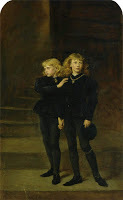 Two children in a hostile world: a Victorian depiction of Edward IV's two sons, who were murdered during the reign of Richard III in the Tower of LondonBut loving Isabella was not the same as sharing her vision and dreams nor the same as respecting her dynastic role as heiress of Jerusalem. In 1186, when Isabella’s older half-sister Sibylla usurped the crown of Jerusalem without the consent of the High Court, the majority of barons were prepared to crown Isabella as a rival queen ― and make Humphrey king of Jerusalem. He was by now at least seventeen years old, more than old enough by the standards of the day to take up the scepter. Baldwin IV, despite suffering from leprosy, had led his armies in person at the same age. Any young man with an ounce of ambition, a trace of courage, or a sense of self-respect would have snatched such an opportunity. Humphrey instead snuck out in the dark of night and groveled at Sibylla and her husband’s feet.
Two children in a hostile world: a Victorian depiction of Edward IV's two sons, who were murdered during the reign of Richard III in the Tower of LondonBut loving Isabella was not the same as sharing her vision and dreams nor the same as respecting her dynastic role as heiress of Jerusalem. In 1186, when Isabella’s older half-sister Sibylla usurped the crown of Jerusalem without the consent of the High Court, the majority of barons were prepared to crown Isabella as a rival queen ― and make Humphrey king of Jerusalem. He was by now at least seventeen years old, more than old enough by the standards of the day to take up the scepter. Baldwin IV, despite suffering from leprosy, had led his armies in person at the same age. Any young man with an ounce of ambition, a trace of courage, or a sense of self-respect would have snatched such an opportunity. Humphrey instead snuck out in the dark of night and groveled at Sibylla and her husband’s feet.The argument that Humphrey did this to save the kingdom from civil war cannot be dismissed out of hand, since even if what came was worse (complete annihilation of the kingdom), Humphrey can’t be blamed for not having foresight. He can, however, be blamed for not having the courage to tell the barons who supported him as king to their faces that he refused to play the role they intended for him. Apparently, he pretended to agree, and then betrayed the barons. His actions were certainly characterized as “betrayal” by the baronial faction later. It is also significant that Humphrey’s step-father, Châtillon, was a major supporter of Sibylla. It is possible, therefore, that his betrayal of his wife may have stemmed from a terror of opposing Châtillon, or a pathological devotion to the man who had beaten him into a stammering “coward.” How this affected his relationship with his wife can only be speculated upon, but while they remained married, it’s hard for me not to see in Isabella’s later willingness to divorce him a wound that cut very, very deep.
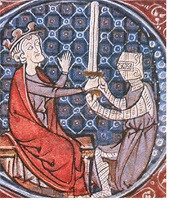
But first, the man to whom Humphrey had done homage, Guy de Lusignan, had to lose the entire kingdom to Saladin. Humphrey is listed in all sources as one of the prisoners taken by the Sultan at the Battle of Hattin, although it’s unclear what purpose our “more girl than boy,” troop-less ex-baron was doing there. He was not released for two years, by which time he spoke excellent Arabic. It is not clear whether he learned it in captivity or already commanded the language. What we do know, however, is that Humphrey did not come out of captivity hating the Saracens as, for example, Châtillon did.
Humphrey promptly joined Guy de Lusignan’s siege of Acre and took Isabella with him. One presumes this was because after two years of separation the young couple (Humphrey was about 21 and Isabella 17) could not bear to be apart. On the other hand, a medieval siege camp was a horrible, unsanitary place infested with disease, whores, rats and insects, and this siege was one in which the besiegers were subject to frequent attacks as well ― not a terribly romantic place to be.
In November 1190, Queen Sibylla and both her daughters died in Acre and Isabella became the heir presumptive to the throne. Unfortunately, however, she needed the consent of the very barons that her husband had betrayed four years earlier. They weren’t having Humphrey. The condition of her coronation was that her marriage to Humphrey be dissolved. This was not difficult, since she had not been the age of consent when it was contracted.
Humphrey tried to retain his bride. He testified that she had consented to the marriage and that the marriage had been consummated. Unfortunately, there were men present willing to challenge his testimony and demand that he defend his words in judicial combat. Humphrey declined.
Why? He must have known that his refusal to defend his testimony with his body would be seen as 1) proof that he lied and/or 2) cowardice. He must have known that by refusing to fight for Isabella he would lose her. Perhaps he recognized that he was too weak to oppose the barons and that he would lose Isabella whether he fought for her or not. Perhaps, being “effeminate” he simply knew he could not win any contest at arms. In either case, Humphrey surrendered yet again, this time his last and arguably most beloved possession ― without a word.
Humphrey is a wonderful character for a novel because he was complex and so very different from your average 12th century knight and baron. He was gentle, fluent in Arabic, self-effacing to a fault, and utterly lacking in ambition. And although he contributed directly to the loss of the Kingdom of Jerusalem by his refusal to take up the scepter in 1186 (thereby enabling the disastrous Guy de Lusignan to become king), I found myself having sympathy for him. My Humphrey is therefore a tragic figure that I hope readers will sympathize with ― even if Balian could not.
Humphrey is a character in the second two book of my Jerusalem trilogy:



Buy now! Buy now! Buy now!
Published on April 22, 2017 23:00
April 15, 2017
Writing Biographical Fiction: Isabella I
 Although Isabella was born a princess and reigned Jerusalem for twelve years, she is most often portrayed in history books and literature as a pawn. She was married four times, divorced once, and widowed thrice. She was the mother of six daughters and a single son, who died before her. She had been besieged by Saladin on her first wedding night, was the object of a coup attempt, and endured the hardships of a siege camp during the Frankish siege of Acre 1189-1191. One husband spent more than year in Saracen captivity, another died in her arms after being struck down by assassins, and her third husband died at the age of 33 in a bizarre accident. Isabella died at the age of 32.
Although Isabella was born a princess and reigned Jerusalem for twelve years, she is most often portrayed in history books and literature as a pawn. She was married four times, divorced once, and widowed thrice. She was the mother of six daughters and a single son, who died before her. She had been besieged by Saladin on her first wedding night, was the object of a coup attempt, and endured the hardships of a siege camp during the Frankish siege of Acre 1189-1191. One husband spent more than year in Saracen captivity, another died in her arms after being struck down by assassins, and her third husband died at the age of 33 in a bizarre accident. Isabella died at the age of 32. Yet while Isabella’s life was short, eventful and tragic, writing Isabella off as a pawn of the men around her does no justice to a woman who played such a significant role in the history of the Holy Land. Thus one of my principal goals as a novelist when developing the character of Isabella was to show her as human being with a mind and a will of her own.
Trying to understand Isabella started with recognizing that her father died when she was only two years old, and that made her the only child of a young widow ― who also happened to be a Byzantine Princess. Furthermore, from the age two to seven, she lived with that widowed mother, the immensely wealthy Dowager Queen of Jerusalem, in her mother’s dower barony of Nablus ― a pretty good formula for being a very spoiled little girl!
It was probably a terrible shock to Princess Isabella when her mother remarried in late 1177. Suddenly she was no longer the center of her mother’s attention and, indeed, she would have been expected to show respect and obedience to a strange man, which may not have come easily. She also probably had to spend some of her time away from her familiar environment in Nablus, and go with her mother and step-father to Jerusalem and Ibelin, where her step-father had property.
From there, however, things only got worse. Three years later she was completely removed from her mother and step-father’s care and sent to live among strangers in the barren border fortress of Kerak under the care of one of the most notoriously brutal men of the age: Reynald de Châtillon. (See earlier entry.) Worse: she was effectively imprisoned, denied the right to even visit her own mother. Allegedly, this was so she could grow up with her future husband, Humphrey IV of Toron.
Humphrey was only a few years older than Isabella, and also a minor living with his mother and stepfather. Later in life he was described as more like a girl than a boy, with a stutter, and cowardly. This was probably the result of being intimidated (not to say brutalized) by his step-father Châtillon, his mother’s third husband and his second step-father. Isabella was later to show great devotion to Humphrey, which led me to hypothesize that the two little children, already promised to one another by their guardians, became friends in a hostile world.
Isabella’s release from Châtillon’s clutches came in a dramatic way. When still only 11 years old, she was “married” to Humphrey in the midst of a siege. (Note: this marriage was illegal because Church law required girls to be at least 12 years of age, unless there was a papal dispensation.) Contemporary accounts claim that the Saracens had already taken the town and the castle itself was under bombardment from Saladin’s siege engines during the wedding. But the castle held out until the army of Jerusalem, led by Isabella’s half-brother King Baldwin IV came to the relief of Kerak.
Humphrey, having presumably reached his majority (age 15 in the Holy Land at this time), and Isabella thereafter set up their own household. Although the details of Humphrey’s estate are vague, a variety of charters demonstrate that Humphrey’s “loving” guardian (Châtillon) had in fact bartered away his hereditary fief (Toron) to the king’s maternal uncle, Joscelyn of Edessa, leaving Humphrey with substantial cash income but no land―something that would have been intensely humiliating since Toron was a great barony and his grandfather had been Constable of the kingdom and one of the most respected noblemen of his age. (Humphrey’s own father died very young and before his grandfather did.) Isabella too, much as she apparently loved her childhood friend, as a princess would have found the lack of any kind of landholding insulting. This state of affairs was clearly the work of the queen mother, Agnes de Courtenay, and intended to check-make Isabella’s ability to raise her legitimate claims to the throne of Jerusalem -- and troops to support that claim. At 11 and 12, Isabella may not have understood this, but her mother and step-father certainly did, and after she was released from Kerak she had contact with both of them again.
In fact, after the death of Baldwin V, Isabella was at Nablus with her mother and step-father when the news came that her half-sister Sibylla had illegally seized the crown of Jerusalem and also crowned and anointed her detested husband Guy de Lusignan. The majority of the barons and bishops of the kingdom, meeting at Nablus, agreed to crown Isabella as a (legitimate) rival to her sister. But that same night her husband, Humphrey, secretly went to Jerusalem and did homage to Sibylla and Guy, check-mating the baronial opposition to the usurpers. Isabella must have felt betrayed, insulted and humiliated by Humphrey’s actions. Her mother and step-father (and the majority of the barons and bishops) had seen her as the rightful queen, yet her own husband did not; such a bald betrayal must have been lacerating to Isabella. I do not believe any marriage would have survived a break of this kind without damage.
We do not know for certain where Isabella was when one year later the news came that the army of Jerusalem had been annihilated at the Battle of Hattin and her husband, along with the king and most of the other noblemen present, had been taken prisoner by Saladin. However, we know that her mother and maternal half-siblings were in Jerusalem. Her step-father received a safe-conduct from Saladin to go to Jerusalem and remove them from harm’s way. We know, furthermore, that Isabella’s paternal half-sister (Queen Sibylla) was also in Jerusalem, because Arab sources write that Saladin did not want her in Jerusalem when he assaulted it. I think, therefore, it probable that Isabella was with her mother in Jerusalem and went with her to Tyre.
On Humphrey’s release from captivity, he joined the Frankish siege of Acre and Isabella went with him. Medieval sieges were not picnics, and this one was particularly horrible. The Frankish forces were completely hemmed in by the Saracens by land and dependent on supplies by sea that could be cut off by enemy action or weather. There was frequent skirmishing, hunger, and disease. Thousands, if not tens of thousands, died in this siege ― including Queen Sibylla and her two daughters. So Isabella, I am forced to conclude was either there by force or she must have still loved Humphrey a great deal, despite his betrayal at Nablus in 1186. Maybe the nearly two years of separation caused by his captivity had made her forgive him and long for him?
At all events, Isabella was sharing Humphrey’s tent in the siege camp when men loyal to the King of France forced their way in, dragged her from her husband’s bed and took her into church custody, while the legality of her marriage to Humphrey was investigated by an ecclesiastical tribunal led by the papal legate. Much has been written about this “abduction” and I refer readers to my own short essay “The Abduction of Isabella.” The gist of the story is that while Isabella initially resisted the thought of divorcing Humphrey “because she loved him,” she changed her mind within a couple of days after her mother made it clear to her that she could not become Queen of Jerusalem unless she agreed to set Humphrey aside. Isabella chose the crown. This is usually portrayed as weakness, a girl being “badgered and brow-beaten” into giving up the man she loved. I doubt that version. Here's why:
First, there were suggestions that the marriage had never been consummated -- after seven years and with both principals both in what should have been sexually active ages. Second, during the investigation of her marriage, Humphrey’s testimony that Isabella consented to their marriage was challenged by a witness. This man called Humphrey a liar and threw down a gauntlet, challenging Humphrey to defend his word in combat. Significantly, Humphrey did not pick it up. In short, the young man who was according to a contemporary, firsthand account (the Lyon Continuation of Tyre based on the lost chronicle of Ernoul) “cowardly and effeminate” was not willing to fight for his wife. Where did that leave Isabella? She had been married to him as a little girl, and she had lived with him for seven years, but first he betrayed her and prevented her from being crowned queen and now he refused to fight for her. I think that while Isabella had clung to Humphrey as her only friend when an imprisoned child at Kerak, she was by the age of 18 tired of a pretty, stuttering youth who was patently unwilling to recognize her as a queen or even defend his own rights. She dumped him. Her sister Sibylla had stuck to her man and lost her kingdom, Isabella shrewdly made the other choice, she dropped her man and gained a kingdom.
Her next husband, Conrad de Monterrat, despite the slander heaped on him by the Itinerarium Peregrinorum et Gesta Regis Ricardi and most modern novelists, was not a monster. He was very well-educated, well-traveled, and an allegedly handsome man, who had charmed the court at Constantinople. He was also ambitious, decisive, opportunistic, courageous and audacious. There is no reason to think Isabella disliked him. Indeed, after the weak and ineffectual Humphrey, who had stood in her way of becoming queen, the virile and ambitious Conrad might have literally swept Isabella off her feet. That is a matter of pure speculation, of course, but it is every bit as legitimate as the usual portrayals of her being miserable with him. Why should she have been? She finally had a man who was willing to fight for her and her rights to the crown.
Unfortunately, however, even Conrad ran into insurmountable opposition in the form of Richard the Lionheart. Richard, for reasons of his own, backed the former King Guy, saying that because he was an anointed king he should rule until his death, after which Isabella and Conrad would be his successors. It must have been intensely frustrating for Isabella to have her claims to the throne sabotaged a second time, but at least this time it wasn't by her own husband.
Eventually Richard of England recognized that Guy was never going to be recognized by the his former subjects, and capitulated. He dropped Guy and recognized Isabella and Conrad as the rightful queen and king of Jerusalem. There was wild jubilation in Tyre -- that turned almost at once to outrage and grief when Conrad was attacked and lethally stabbed by two assassins. Dying, he was brought to Isabella, and bleeding from the well-placed wounds he died in her arms. The experience would have been traumatic no matter what her feelings for Conrad had been.
Isabella had no time to grieve. She was recognized as the Queen of Jerusalem at last, but constitutionally she needed a consort and politically, with Saladin still in occupation of most of her kingdom and the Third Crusade already disintegrating, she needed a consort capable of defending her fragile kingdom. She knew that ― just as she knew that it was not her choice. The High Court of Jerusalem would decide her next husband. Within just days they chose a 24-year-old Frenchman, the grandson of Eleanor of Aquitaine and nephew of Richard of England: Henri de Champagne. Isabella and Henri married just eight days after the assassination of Conrad.
And what did Isabella feel about it all? We don’t know but there is one account that says that Isabella personally came to a reluctant Henri de Champagne to assure him that she was in agreement with the marriage. He was allegedly so charmed by her that he abandoned all his scruples and reluctance to take up the burden of Jerusalem.
In summary, my Isabella was spoiled in her early childhood but tempered by extreme hardship and cruel disappointments into a woman who identified with her kingdom. She repeatedly demonstrated her willingness to subordinate her own feelings to the best interests of her kingdom. In this, I think she was very much her mother’s daughter, imbibing with her mother’s milk a strong sense of imperial dignity and destiny. I think Isabella’s ties to her mother were very strong, albeit tested by the breaks, and probably stormy as I see them as both very strong personalities. As for her relationship with her husbands, I think she loved Humphrey as a child but felt betrayed by him and frustrated by his apparent homosexuality. I think she was at first a little infatuated by Conrad, because he was so different and so forceful, but that she would likely have found him overbearing and difficult very soon; he was not the kind of man to be considerate of others, not even his wife. (He'd had two already, after all.) In Henri, however, I think Isabella found a young man she could truly love.
Find out more by reading my Jerusalem trilogy:



Buy now! Buy now! Buy now!
Published on April 15, 2017 01:35
April 8, 2017
Writing Biographical Fiction: Reynald de Châtillon

Reynald de Châtillon is another historical figure who was highly controversial in his own life-time. From the 19th century onwards, he has generally been cast in the role of villain and blamed for the fall of the Kingdom of Jerusalem. The modern popular image of Châtillon has largely been shaped by the Hollywood film “The Kingdom of Heaven,” in which he is depicted as a madman bent on war regardless of consequences. But the noted historian Bernard Hamilton argues persuasively that Châtillon was a brilliant strategist, whose actions did more to help than hurt the Kingdom of Jerusalem. More recently still, the journalist Jeffrey Lee has written a light-weight popular biography in which he seeks to completely rehabilitate Châtillon, arguing he was no more violent than his fellows and suffers only from a bad press.
As a novelist, this character clearly offered significant potential, as a brief summary of his colorful career highlights.
Châtillon was born in 1125, the younger son of a French nobleman, who joined the Second Crusade. Apparently, while Louis VII was worrying (probably unnecessarily) about his wife Eleanor committing adultery with her uncle Raymond of Poitiers, Châtillon was busy seducing Raymond’s wife, the heiress of the Principality of Antioch, Constance. No sooner had Raymond been killed in an ambush in 1153, than Constance took the comparatively obscure and still young (he was 28) Châtillon for her second husband. It worth noting that according to the excellent history written by Châtillon’s contemporary, the Archbishop of Tyre, the King of Jerusalem had suggested to Constance a variety of other “suitable” bachelors — men of stature and proven ability in the crusader states, but the lady chose the less suitable Châtillon. It was clearly a case of a widow exercising her right to choose her second husband, and so a “love” match — at least on Constance’s part. As a novelist, therefore, I had to assume that Châtillon ― at least at this stage of his life ― was a charmer.
Within a very short period of time, however, Châtillon also demonstrated levels of avarice and violence that scandalized his contemporaries. Tyre claims that out of sheer animosity to the Patriarch of Antioch (who had opposed Châtillon’s marriage and didn’t hesitate to say so publicly), Châtillon had him seized, bound, beaten and then exposed to the blazing summer sun with his head covered with honey. The honey and blood attracted the flies and the old man, the highest church official in Châtillon’s lordship, was tormented with heat and flies until he agreed to pay Châtillon a large sum of money.
Châtillon next attacked the Island of Cyprus, a Christian country under the authority of the Byzantine Emperor. As Tyre points out Cyprus “had always been useful and friendly to our realm.” Châtillon’s justification for the raid was that he had not been paid by the Emperor for his service in subduing the rebellious Armenian Lord Thoros of Cilicia. The ravaging lasted for days, showing “no mercy to age or sex,” (again according to Tyre) and this time so scandalized Châtillon’s contemporaries that the King of Jerusalem, Baldwin III, offered to deliver him to the Byzantine Emperor.
Manuel I opted instead to invade Antioch himself, and force Châtillon to submit personally. As the army of the Emperor approached, Châtillon recognized he didn’t stand a chance of defying the Emperor (and probably realized he was in the wrong with no allies) so he threw himself on the Emperor’s mercy in a dramatic gesture: He went barefoot to the Emperor with a noose around his neck and presented his naked sword hilt-first to the Emperor. As Tyre dryly noted, Châtillon “was a man of violent impulses, both in sinning and in repenting.”
In 1161, Châtillon was captured by the Seljuk leader Nur ad-Din and imprisoned in allegedly brutal conditions. He was not released for 15 years, by which time his wife, Constance of Antioch had died and her son by her first marriage had come of age. Notably, the new Prince of Antioch did not want his step-father around – which tells us something about what sort of a step-father he had been to the young prince. Châtillon penniless was now 52 years old and prince of nothing (although he insisted on being addressed by this title for the rest of his life). Indeed, he was landless and penniless.
He rapidly remedied his situation by marrying another widow. This time it was the lady of the vast and important frontier barony of Oultrejourdain, Stephanie de Milly. It is hard to imagine that a man recently released from fifteen years in a Saracen prison and well past his prime was particularly attractive to Stephanie, but maybe we should give her (and not just the High Court) credit for perceiving Châtillon’s value as a brilliant tactician, capable of defending her vulnerable inheritance.
He defended his new lordship by dramatically going on the offensive. In November 1181 he led a raid deep into Sinai. This raid has contributed to his reputation as a war-monger because it occurred in the middle of a truce. However, far from being an opportunistic act of an adventurer the raid served a vital strategic goal: it prevented Saladin from seizing Aleppo at the death of Nur-ad-Din’s legitimate heir. Instead, Salah ad-Din’s forces had to be diverted to interdict Châtillon’s raid.
A year latter, Châtillon expanded on his probably ad-hoc raid into Sinai by launching a fleet of ships in the Red Sea. These raids have generally drawn approbation from historians, who portray them as cruel piracy against innocent pilgrims. However, by threatening the trade and pilgrim routes of the Red Sea, Châtillon challenged Salah-ad-Din’s claim to be the Defender of Islam. The campaign had the added advantage of aiding the Frank’s allies in Syria, while restraining Salah-ad-Din’s growing power. In short, far from being acts of piracy by a “rogue” baron, these raids served a clear strategic purpose.
During the succession crisis after the death of Baldwin V, Châtillon threw his weight behind Sibylla — but it is unclear if he supported Guy de Lusignan or not. He is said to have urged the people of Jerusalem to accept Sibylla without naming Guy as her consort. He may have been one of those who urged her to set Guy aside and take a new husband (maybe he even imagined himself as her consort given his past successes?).
At the Battle of Hattin, Châtillon fought bravely beside the King and was taken captive with him along with many other nobles. The only thing that made him different from the others is that Salah-ad-Din was not willing to forgive the Red Sea Raids and — in violation of Islamic practice — did not show mercy. Salah-ad-Din allegedly killed Châtillon with his own hand — or wounded him and let his men finish him off. It was a violent end for a violent man; he may well have preferred it to the thought of languishing again in a Saracen prison or a life in slavery. He would have been 62 years of age at the time of his execution.
As a novelist, I wanted to show that Châtillon was far more complex and intelligent than the buffoon of “The Kingdom of Heaven.” My Châtillon, in consequence, is a ruthless but brilliant strategist. I opt to have him in league with King Baldwin with respect to the Red Sea Raids, because this added a new dimension to the “Leper King” as well, underlining the young king’s determination to defend his kingdom.
But there was another very important piece of Châtillon’s biography that is easily skipped over by historians, yet central to a novel about Balian d’Ibelin and his wife Maria Comnena: Châtillon was the man who took control of Maria’s first born child, Isabella, when the latter was sent to live with her future husband, Humphrey de Toron, at the age of eight. Humphrey de Toron was the son of Châtillon’s wife by an earlier marriage, and as such Châtillon was his de facto guardian. What is more, we know that Châtillon’s wife (the chronicles curiously always blame his wife, not him) refused to allow the little girl to visit her mother for three years.
While historians generally put this down to the “wise” (really?) efforts of Châtillon and the royal party in removing the king’s little sister from the “evil” (really? Evidence please!) influence of Queen Maria and “the Ibelins.” Yet, from the perspective of a novelist, there is a great deal more going on here. Isabella was only eight when she was taken unexpectedly from the only home she had ever known. She was then sent to one of the most endangered castles in the kingdom, Kerak, and turned over to a man with a reputation for brutality. While in his “tender” (?) care, she was not allowed to visit her own mother, and then forced into a marriage before she reached the age of consent, which from our perspective was already scandalously young: 12. To top it off, the marriage took place while the castle was under siege from Salah ad-Din. Now if that isn’t material for a novel, what is?
But there’s more! Châtillon was the guardian of Isabella’s young husband, Humphrey de Toron. It is recorded that Humphrey was “more like a girl than a boy,” that he stuttered and was “cowardly and effeminate.” Apparently, Châtillon’s methods of raising youth to manhood was, shall we say, intimidating. A thesis supported by the fact that his step-son by his first wife also loathed him and did not want him in his kingdom.
In short, two children were handed over to the care of a man who tortured prelates of the church, plundered peaceful Christian countries and routinely broke truces. No matter how strategically useful his later raids were, this is not the kind of man I would want raising my eight-year-old daughter, or my teenage son either! Yet the very terror he imposed on them may have made them seek comfort from one another. This is the emotional response that I explore in my novel.
Châtillon and his wife thus play important roles in the second book of my Jerusalem trilogy.
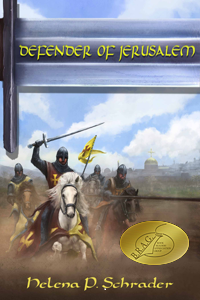
Buy Now!
Published on April 08, 2017 23:00
April 1, 2017
Writing Biographical Fiction – Richard the Lionheart
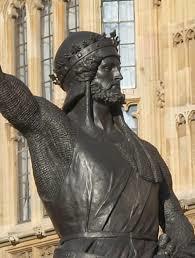 Richard the Lionheart plays a central role in Envoy of Jerusalem, and he is without doubt the one character that every reader has at least heard of. Indeed, most readers probably already have an opinion about Richard before opening the first page of my book, because Richard the Lionheart’s popularity in popular culture goes back at least to the time of the first Robin Hood legends – whenever that was! Today he is familiar from scores of Hollywood films and hundreds of novels. So I knew from the start that readers would come to my book with a picture of him already in their minds.
Richard the Lionheart plays a central role in Envoy of Jerusalem, and he is without doubt the one character that every reader has at least heard of. Indeed, most readers probably already have an opinion about Richard before opening the first page of my book, because Richard the Lionheart’s popularity in popular culture goes back at least to the time of the first Robin Hood legends – whenever that was! Today he is familiar from scores of Hollywood films and hundreds of novels. So I knew from the start that readers would come to my book with a picture of him already in their minds.To make things even more difficult, Richard was highly controversial even in his own lifetime. He was seen by the Church as excessively proud, greedy and sexual. He was detested by the German Emperor, his own brother John, and the French King. On the other hand, he was adored by his hard-headed, practical and highly political mother -- and by his troops. Furthermore, despite the best efforts of his brother John and the King of France, he retained the loyalty of most of his vassals and subjects as well.
To this day historians and laymen tend to fall into “pro” or “con” camps. It seems as if people just can’t be indifferent to Richard. The main sources of contemporary contention are: 1) whether Richard was a “good” or a “bad” king for England; 2) whether Richard was homosexual or not; 3) whether Richard was a stupid, bloodthirsty brute or an intelligent and judicious king and commander. Since my novel is set exclusively in the Holy Land, the first question isn’t terribly relevant, but answering the latter two, particularly the last, was important. So before writing anything, I tried to find answers to these questions and come to a personal understanding of this complex and controversial king. As a second step, I then reflected on how the man I “discovered” would have interacted with my characters.
Richard, it seems to me, was a product of his age, birth and upbringing. Born a prince to two of the most ambitious, politically savvy, proud and passionate people of the 12th century, Richard had little chance of being humble, meek, dispassionate, indecisive, or easy-going. Richard and his brothers fought their father and each other as well as their liege lord Philip II and any rebellious vassal that dared raise his head. Clearly, Richard was ambitious, aggressive and tenacious, but his heritage also ensured that he was politically astute and acutely attuned to shifting alliances and power constellations.
Richard was, furthermore, only 13 when he was first invested with authority as Duke of Aquitaine. While children in the Middle Ages undoubtedly grew up faster than children do today, that is still a very young age to be raised to such high status. It is hard to imagine that the dignity, power and importance of this title did not go to his head. So Richard would never have been humble or self-effacing, but he was also unlikely to have been touchy about his titles. They were not something new or something he had to guard consciously because by the time he came on crusade they were an organic part of him.
Another thing that struck me was that Richard’s relationship with his father was far more complex than that of an impudent son, but while fascinating this wasn’t all that relevant to my novel. Richard’s deep love for his mother, on the other hand, was relevant because it must have influenced his attitude toward women generally ― and sexual relations are important in any novel. Richard’s relationship with his mother was forged when he was at her court in Poitiers from the ages of nine to thirteen. He surrendered the Aquitaine to her and her alone, trusting her not to give it to one of his brothers. His very first act as king was to order her release from detention. He sought her advice when he was with her and entrusted her with royal authority during his absence. Arguably there was no other human being that he trusted as much as he trusted his mother. A man who has that much respect for a woman’s intelligence and political acumen is bound to respect other intelligent women, and this was an important insight for my novel as it dictated how Richard would react to and inter-act with my female protagonist, Maria Comnena.
At the same time, Richard was anything but a “mama’s boy.” He was strong, athletic, and comradely. He won the affection of his troops because he could swear, fight and whore as hard as they did. Indeed, the Church was highly critical of his sexual excesses. It has become popular to impute homosexuality to Richard, but there is no evidence that he was suspected of this in his lifetime. Certainly, he had mistresses and at least one illegitimate son, so if he was also a practicing homosexual he was bi-sexual. We will probably never know what his sexual preferences were and, frankly, I don’t much care. In my novel I chose to stick to the contemporary image of Richard as heterosexual.
What did strike me as exceptional, however, was his willingness to do manual labor. This was anything but self-evident in a medieval nobleman, much less a king. Yet the Itinerarium Peregrinorum et Gesta Regis Ricardi claims that Richard helped rebuild the defenses of Ascalon “with his own hands,” and describes his example inspiring everyone to work together handing the stones up to the wall (Book 5, Chapter 6). The willingness to do menial labor reveals just how sure Richard felt in his own skin. He was so sure of his own innate nobility that he had no need for royal symbols or ceremony. It was perhaps this that later enabled him to endure captivity at the hands of the Holy Roman Emperor. For my novel it was simply an important characteristic.
I was also won over by Richard’s leadership style. Richard was a brilliant strategist – who also led from the front. He risked his own life, but was very cautious with the lives of his soldiers. He understood logistics as well as strategy, and he won his battles with a combination of careful planning and sheer audacity. As one of my readers put it, in the end, I just had to love Richard.
For the most part, therefore, “my” Richard reflects the above characteristics, but the plot of Envoy of Jerusalem required going beyond this fundamental character and looking specifically at Richard’s role in the Third Crusade. On the one hand this meant his continuous quarreling with the French under Philip II and Hugh of Burgundy, and on the other hand his interaction with the barons of Outremer and his initial support for Guy de Lusignan. With regard to the former, I accepted historical consensus that Richard and Philip’s rivalry and hostility was both a clash of personality and fundamental interests. With the later, however, I had to look deeper as this was the very essence of my novel: the evolving relationship between Richard and Ibelin.
Here too, it was rapidly evident that Richard and Ibelin were in many ways opposites in background and character. Richard was born to privilege; Ibelin had to claw his way up by marriage and merit. Richard was flamboyant and showy; Ibelin was humble and retiring. Richard was renowned for his prowess on the battlefield, a man of immense physical strength and skill with arms; Ibelin’s greatest achievements were diplomatic. Richard led from the front with spectacular displays of bravery; Ibelin’s military skills were more organizational and inspirational.
Yet arguably what most set Richard and Ibelin apart was that Richard was crusader, while Ibelin was a native of Outremer. This simple fact determined their initially opposing attitudes and positions at the start of the Third Crusade. Richard arrived in the Holy Land determined to regain Jerusalem ― and consciously or unconsciously convinced that the men of Outremer had lost it, either through their sins or their incompetence. Richard, like other crusaders from the West, were quick to see the natives of Outremer as decadent and compromised. Ibelin, naturally, placed the blame for the catastrophe on its architect, Guy de Lusignan.
It was Richard’s support for Guy de Lusignan, therefore, that initially put Ibelin and the Plantagenet on a collision course. Ibelin recognized Conrad de Montferrat in place of Guy as the rightful king of Jerusalem. Because of this, he was willing to act as Montferrat’s envoy to Saladin in the fall of 1191. This put him in direct conflict with Richard, because Montferrat was willing to cut a deal with Saladin behind Richard’s back. (Saladin called Montferrat’s bluff, and broke off the negotiations with him, but the fact that Ibelin had represented Montferrat in some (though not all) of these negotiations naturally made him seem a traitor, at least in the eyes of some of Richard's followers and later chroniclers.
Yet less than a year after his arrival in the Holy Land, Richard was forced to recognize that he had seriously misjudged Lusignan. He recognized further that his continued support for the strategist of the disaster at Hattin endangered all that he had achieved with his crusade. It is to Richard’s credit that he both recognized his mistake and was willing to reverse his policy.
After Champagne’s election as King of Jerusalem, Ibelin supported Richard’s crusade. He is specifically named as commanding (again) the rear-guard of the army sent to the relief of Jaffa (after Richard went by ship to stiffen the resistance of the garrison). He is also listed as the first and foremost of the emissaries Richard sent to Saladin to negotiate a truce that would enable Richard to return home to his threatened inheritance. Obviously, this had in part to do with the fact that Ibelin had distinguished himself in negotiations with Saladin before, notably at Jerusalem. Nevertheless, no man selects an envoy he does not trust and respect.
It is therefore safe to say that in the almost exactly 16 months that Richard the Lionheart spent in the Holy Land, he came to appreciate, respect, and possibly even like the so very different Baron of Ibelin. It is this evolving relationship that I describe in Envoy of Jerusalem -- as well as attempting to do justice to the complex historical figure that Richard I Plantagenet undoubtedly was.
Richard the Lionheart is a major character only in "Envoy of Jerusalem"

Buy Now!
Published on April 01, 2017 23:00
March 25, 2017
Writing Biographical Fiction: Queen Sibylla of Jerusalem
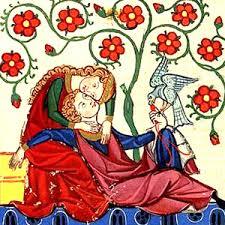 Sibylla of Jerusalem is a historical figure I intensely dislike ― but she is great novel material. Theantithesis of the power-hungry woman, she consistently put her affection for her second husband above the well-being of her kingdom. In so doing, she doomed her kingdom to humiliation, defeat and almost complete annihilation. That is not something I find admirable, but as the following short biography highlights her behavior was astonishingly consistent and comprehensible.
Sibylla of Jerusalem is a historical figure I intensely dislike ― but she is great novel material. Theantithesis of the power-hungry woman, she consistently put her affection for her second husband above the well-being of her kingdom. In so doing, she doomed her kingdom to humiliation, defeat and almost complete annihilation. That is not something I find admirable, but as the following short biography highlights her behavior was astonishingly consistent and comprehensible.Sibylla was born in 1160, the eldest child of Amalric of Jerusalem. Three years later, her father repudiated her mother in order to become king. Although Sibylla and her brother Baldwin were explicitly recognized as legitimate, their mother was banished from court and Sibylla, despite her tender age, was sent to the convent at Bethany near Jerusalem to be raised by her father’s aunt.
Ten years later, her younger brother Baldwin contracted leprosy. This meant that he might not live to adulthood and, even if he did, he was unlikely to have heirs of his body. Finding a husband for 10-year-old Sibylla was suddenly of paramount importance to the kingdom. The Archbishop of Tyre was dispatched to the West to find a suitable nobleman and returned with Stephen of Sancerre, the brother-in-law of the King of France. But Stephen unexpectedly refused to marry Sibylla and returned to France, squandering his chance to be King of Jerusalem. It is hard to imagine what about a little girl living in a convent could have so offended an ambitious noblemen, so it is probable that his decision had nothing to do with Sibylla at all. Nevertheless, while his motives are historically unimportant, as a novelist the incident is highly significant: Sancerre probably hurt Sibylla deeply and may have severely damaged her self-confidence―something that later men would have been able to exploit.
In 1174, Sibylla’s father died unexpectedly and her younger brother ascended the throne as Baldwin IV, but this changed nothing with respect to the need to find a husband for Sibylla. This time the king, his regent and the High Court chose William Marquis de Montferrat, who arrived in the Holy Land in October 1176. Within six weeks, he married the then 16-year old Sibylla. There is no reason to think that Sibylla was ill-pleased with this choice of husband, or he with her. He certainly did not reject her and she became pregnant shortly after the marriage. Unfortunately, William de Montferrat became ill within six months and after eight, in June 1177, he was dead. Seventeen-year-old Sibylla gave birth to a posthumous son in August, who was named Baldwin after the king.
At once the search for a new husband for Sibylla commenced. The Count of Flanders, as a close kinsman (his mother was Sibylla’s aunt) felt he was entitled to select Sibylla’s next husband, and put forward the name of one of his vassals. Furthermore, he wanted to marry Sibylla’s half-sister to this man’s younger brother, thereby binding both princesses to his vassals — a crude means of making himself master of the kingdom without actually doing the hard work of fighting for it. This was, understandably, unacceptable to the High Court of Jerusalem. The Count of Flanders returned to Europe and Sibylla was still without a new husband. What did Sibylla feel about it all? None of the clerical chroniclers care, but as novelist she may have felt insulted (as her brother and the High Court did), or she may have started to enjoy her freedom. After all, she’d already given Jerusalem an heir and her brother was starting to include her on his charters, effectively sharing government with her (at least in appearance.)
Meanwhile, however, King Baldwin, wrote to the King of France and begged him (Louis VII) to choose from among his barons a man who could take up the burden of ruling the “Holy Kingdom” (i.e. the Kingdom of Jerusalem). Louis chose Hugh, Duke of Burgundy, a very high-ranking nobleman indeed. He was expected to arrive in the Holy Land in spring of 1180. Instead, the Duke of Burgundy sent his regrets: the King of France had died leaving the kingdom to his young son Philip II and the Plantagenets were strong and predatory. Burgundy felt he had to remain in France to defend it. While Burgundy’s excuse is plausible, I seriously doubt his reasoning was much comfort to Sibylla. I imagine she (again) felt slighted and insulted.
Abruptly at Easter 1180, only weeks after Burgundy’s decision was made known to her, Sibylla married the landless, fourth son of the Lord of Lusignan, Guy, who had only recently arrived from the West. Some sources (notably the Archbishop of Tyre) suggest her brother rushed her into an admittedly unwise and hasty marriage to block an unwanted suit by the Baron of Ramla. A better explanation of what happened is offered by another contemporary chronicle (now lost) but quoted in later sources, Ernoul. According to Ernoul, Guy de Lusignan seduced Sibylla and King Baldwin threatened to hang him for “debauching” a Princess of Jerusalem, but was persuaded by his mother (the self-serving and far from intelligent Agnes de Courtenay) and the tears of his sister to relent and allow Sibylla to marry.
This explanation of events appears very plausible. Sibylla had just been jilted for a second time. She was probably feeling very sorry for herself and may even have been wondering if something was “wrong” with her. Suddenly, there was a dashing, handsome, young nobleman paying court to her, flattering her, making love to her. She fell for him. Not a terribly unusual thing for a 20 year old girl, especially one who was, after all, no virgin but already a widow and mother.
Furthermore, the evidence that Guy was Sibylla’s rather than her brother’s choice is provided by subsequent events. Within three years, Baldwin IV was desperately trying to find a way to annul the marriage, while Sibylla was doing everything she could to preserve her marriage. What is more, after her brother and son’s deaths, when told she could only become Queen if she divorced Guy, she agreed on the condition she be allowed to choose her next husband―and as soon as she was crowned and anointed she chose Guy as her “next” husband. By clinging to Guy as her husband and consort, she alienated not only the barons and bishops already opposed to her but also those who had loyally supported her on the condition she divorce Guy. These are not the actions of a woman in a dynastic marriage, but very consistent with the behavior of a woman desperately in love with her man.
Guy soon proved all his opponents right when within a year of usurping the throne (since he was never approved by the High Court he was not legally King of Jerusalem), he had lost roughly 17,000 Christian fighting men at an avoidable defeat on the Horns of Hattin. Guy himself, furthermore, was a captive of Saladin. Sibylla, meanwhile, found herself trapped in Jerusalem as her no-longer defensible Kingdom crumbled before Saladin’s onslaught. She was the reigning, crowned and anointed Queen, yet at this critical juncture she did nothing — except beg to be allowed to join her husband in captivity. A queen? Asking to be allowed to go into enemy captivity? This is more than a gesture of love, it is evidence of Sibylla’s utter stupidity and lack of sense.
Saladin naturally granted Sibylla the right to join her husband in captivity — what better way to ensure that his enemies were completely in his hands? Meanwhile, the defense of the last remnants of her kingdom fell to her brother-in-law by her first marriage, Conrad de Montferrat, and the Baron of Ibelin.
But Sibylla’s devotion to Guy was not broken even by the humiliation of captivity. When he was released, she joined him at the siege of Acre. Here, while the Christians surrounded Muslim-controlled Acre, Saladin’s forces surrounded the Christian besiegers, hemming them in and cutting them off from supplies and reinforcements by land. Deplorable conditions reigned, including acute hunger at times and, eventually, disease. Yet Sibylla, crowned Queen of Jerusalem, preferred to be with her beloved Guy than act the part of queen―or even protect her dynasty. She not only followed Guy to Acre, she took her only surviving children, two daughters, with her. She soon paid the price of her blind devotion to Guy: she died of fever along with both her daughters in the squalor of the siege camp at Acre in 1190. She was 30 years old.
Normally, it is admirable for a wife to be devoted to her husband, and a novelist looking for a historical romance could make a great love story out of Sibylla and Guy. But I don’t write romance, and as a historian it is clear that Sibylla shares the blame for losing the Holy Land because it was her stupidity and stubbornness that left the kingdom in the hands of an incompetent and despised man. At no time in her life did she show even a flicker of responsibility for the hundreds of thousands of Christians entrusted to her care nor did she demonstrate a shred of royal dignity. Had she been a baker’s daughter and a butcher’s wife her devotion to her husband might have been admirable; as a princess/queen she was a tragic clown.
And that’s exactly how I portray her in my novels.
Sibylla is an important character in the last two books of my Jerusalem trilogy.



Buy now! Buy now! Buy now!
Published on March 25, 2017 23:00
March 19, 2017
Writing Biographical Fiction: Guy de Lusignan

Writing about Guy de Lusignan in my Jerusalem trilogy posed serious problems for me. He played a fateful (not to say fatal) role in the history of the Kingdom of Jerusalem, and hence ignoring him was not an option. Indeed, he is such a significant historical figure that one of my test readers kept urging me to give him a larger role and more space in the novels. To do that, however, I would have had to be able to get inside his skin and see the world through his perspective ― something I found very difficult to do well. I simply do not understand how anyone could have been as stupid, stubborn and arrogant as Guy de Lusignan.
The situation is complicated by the fact that, as with most of these historical figures from so long ago, there are many things we don’t know about Guy ― starting with his date of birth, and hence his age when he seduced Sibylla. Another thorny issue is whether the contemporary allegations against Guy as the murderer of the Earl of Salisbury are true or not. Developing a character depends very much on whether you believe him capable of stabbing an unarmed man in the back―or not.
Even more difficult for a novel set in the Holy Land is the complete blank in the historical record about why the barons of Jerusalem almost unanimously refused to accept Guy as regent after campaigning under him in the fall of 1183. Guy had been named regent, he had called up the feudal army, and they had all come. In short, the subsequent revolt was not a fundamental refusal to serve under Guy. If, as historians suggest, it was just resentment of a comparative new-comer or an “unworthy” husband for Sibylla, they wouldn’t have mustered at all. The barons did not revolt against Guy until after the campaign of 1183. But then their revolt was overwhelming and emphatic, refusing to go to the relief of the critical border castle of Kerak and the rescue of the the King’s sisters and mother, until Guy had been dismissed and Baldwin IV had resumed the reins of government. Somethinghappened. But we don’t know what, and without knowing what, it is very difficult to craft a character. Something about him that alienated his fellow barons, including Balian and his brother, but just what was it?
Of course, one could argue that the absence of historical documentation opened the way to more creative speculation on my part. True. But, I confess, I drew a blank. I just couldn’t picture vividly enough what sort of man this Guy was.
Several novelists have taken the approach that he was simply a weak-willed dandy easily manipulated by stronger men such as the Templar Master Ridefort and Reynald de Chatillon. But does weakness provoke aversionon the part of stronger men? The absolute hatred that would induce a man to renounce all his titles and surrender all his property (as Baldwin of Ramla and Mirabel did) rather than serve him? Does weakness alone engender so much contempt that a man would prefer to commit treason (as Tripoli did) rather than serve him? Maybe, but I wasn’t entirely convinced.
And what was it about this man ― who provoked such negative reactions from his male peers ― that attracted the love of a twenty-year-old princess? Sibylla, whether she was seduced by him before their marriage or not, was passionately loyal to Guy to the day she died. Her love for Guy led not only to the loss of her kingdom, it led her into Saracen captivity and finally to her death. Had she not followed him to the siege of Acre, she would not have died along with her infant daughters in 1190. Whatever else one has to say about Sibylla, she was a devoted wife!
So Guy couldn’t have been all bad, right? Again, I’m not so sure.
It was that uncertainty made it difficult for me to conjure up a character that was credible, convincing and compelling. In the absence of a compelling character capable of telling me what he thought, said and did, I had only one choice: to give him as small a role as history would allow.
Guy de Lusignan is a minor character in my books. He is viewed mostly from the outside, through the eyes of Balian and others. Only very occasionally do I step inside his skin and show the reader how Guy’s might have understood his circumstances and surroundings. These are critical junctures, in which I felt a rare sense of insight, but for the most part Guy remained an enigma to me. I leave it to another novelist to try to find and reconstruct Guy’s personality in greater detail and nuance.



Buy now! Buy now! Buy now!
Published on March 19, 2017 00:00



